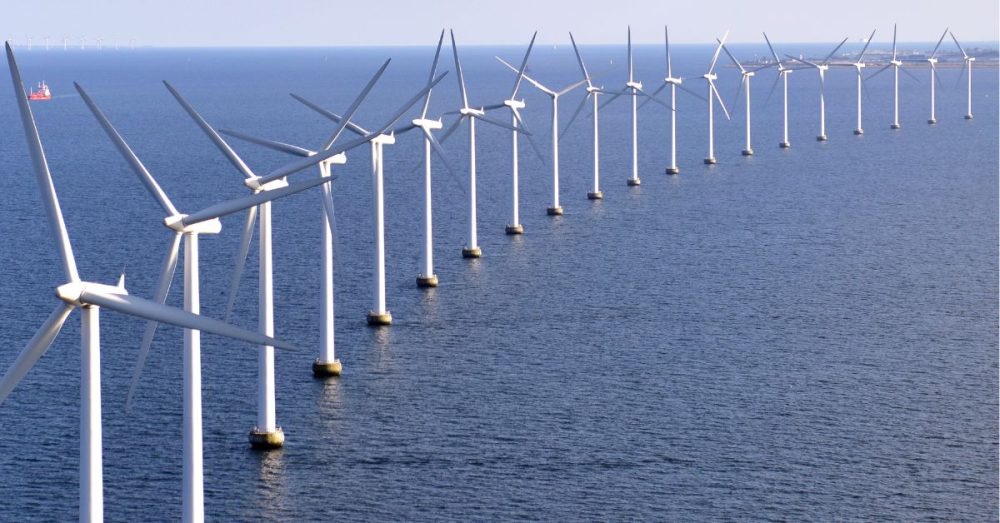Fishermen are taking aim at offshore wind projects across Texas and the United States.
On the same day that the Biden Administration pulled the plug on the second lease auction of a major proposed offshore wind project near the LA-TX border, the Bureau of Ocean Energy Management (BOEM) announced that it had been approached by “Hecate Energy Gulf Wind LLC (Hecate Energy) to acquire commercial wind energy lease(s) on the Outer Continental Shelf (OCS) in the Gulf of Mexico.”
This potential project would transform thousands of aquatic acres into a wind farm.
“The areas are located off the coast of southeast Texas and had been previously identified by BOEM as potential Wind Energy Areas (WEAs) suitable for offshore wind leasing in 2021. WEA Option C totals 74,113 acres, and WEA Option D totals 68,239 acres, for a total of 142,352 acres,” BOEM said at the time.
The Bureau invited interested parties to offer their thoughts as the project continues to develop.
“To comment on the RFCI, go to www.regulations.gov and search for BOEM-2024-0039. BOEM may use comments received to further identify and refine the area(s) being considered for wind energy development and inform future environmental analyses related to the potential lease area.”
In an email to The Dallas Express, the Southern Shrimping Alliance (SSA) expressed its openness to collaboration but remained deeply concerned.
“SSA collaborates constructively with BOEM and [National Centers for Coastal Science] to deconflict offshore wind energy development in the Gulf with the shrimp industry, but the unsolicited Hecate project would rob the shrimp fleet of access to valuable fishing grounds at a time when the industry is facing an existential crisis due to shrimp imports,” explained John Williams, executive director of the Southern Shrimp Alliance.
“The offshore turbines Hectate plans to use are unproven against the force of a Category 5 hurricane,” continued Williams.
“The company is rushing its proposal without understanding the potential impacts of wind turbines on maritime radar or harm to sensitive species and habitats, both of which would impact Gulf shrimpers. Bottom line, the shrimp industry cannot pay the price for developing our nation’s energy needs,” he added.
Part of the existential crisis stems from shrimp prices, which have been driven to some of the lowest levels in decades due to foreign competition.
Much of the imported product competing with American shrimp comes from India. In April, U.S. Rep. Troy Nehls (R-TX) introduced the Save Our Shrimpers Act, which would prohibit the use of American taxpayer funds by international financial institutions for any activity related to producing, processing, or exporting shrimp in foreign countries.
The concerns about wind turbines’ ability to withstand the elements of the ocean environment were exacerbated by the mysterious break-up of an offshore turbine amid clement weather at Vineyard Wind near Nantucket, Massachusetts.
Bonnie Brady, Executive Director of the Long Island Commercial Fishing Association, has gathered video documentation of the shards of turbines and other connected material that have continued to wash ashore since the turbine blades first collapsed in mid-July. “@VineyardWindUS blade disaster debris field has grown. Now at Montauk and Napeague, Long Island, NY. 74.6 miles away,” she posted.
“Get ready, Montauk,” she warns as she holds up hand-sized debris, which she calls “heavy.” It is unclear what the debris is made of; however, wind turbine blades are often constructed of fiberglass-reinforced polyester or epoxy.
@VineyardWindUS blade disaster debris field has grown. Now at Montauk and Napeague, Long Island, NY. 74.6 miles away#ThanksKlaus #ThanksGEVernova #ThanksBOEM @News12LongIsla1 @FoxNews @ACKCurrent @Newsday @EHStar @ABC7 @CBSNews @JesseBWatters @WNBC @ack4whales @GreenOceansRI… pic.twitter.com/83YXlcDfNq
— Bonnie Brady (@mtkblb) August 18, 2024
This August 17 tweet was preceded by other tweets documenting the incident on July 20.
@GovKathyHochul @GovernorVA @GovMurphy @GovJanetMills @GovNedLamont @MassGovernor @GovWesMoore @JohnCarneyDE @NC_Governor @GovernorVA @GavinNewsom @TinaKotek
This will be your legacy; #OSWDestructionByLandAndBySea
Stop the madness while you still can, because when the… https://t.co/N5q11aKzcj pic.twitter.com/xT6AmMcrmS— Bonnie Brady (@mtkblb) July 21, 2024
Brady and others frequently raise concerns about how chemical contamination from wind turbines could affect the health of humans and fish stocks. BPAs and epichlorohydrin are two chemicals in an epoxy that coats most wind turbine blades. BPAs are known hormone disruptors and epichlorohydrin in high enough doses can have “detrimental effects on the liver, kidneys, central nervous system [of humans],” according to the Environmental Protection Agency.
Every year, some quantity of these chemicals are eroded into the environment. The Douglas County Rural Preservation Association wrote that “33% of that eroded material is BPA, resulting in 45 pounds of PBAs released into the environment, per turbine, per year.”
American Clean Power, an association of wind and hydroelectric power producers, disputes this claim.
The association wrote, “Wind turbine blades’ protective coatings are non-toxic and contain negligible amounts of BPA, and the blades are specifically designed to have high resistance to weathering.”
Recently, Brady tweeted images of an offshore wind farm serviced by large ships and a video of a vast expanse of ocean covered by wind turbines. She appeared to take issue with the industrialization of oceans while fishermen attempted to fish.
“Our oceans are being sold to the highest bidder with zero concern for our U.S. seafood supply or the ocean itself. Complete industrialization; an IRA-funded foreign government and/or private equity-owned #OceanGrabbing fire sale of our 3-200 mi EEZ. Thousands of them coming to every coastline unless people wake up now,” she posted.
Our oceans are being sold to the highest bidder with zero concern for our US seafood supply or the ocean itself.
Complete industrialization; an IRA-funded foreign government and/or private equity-owned #OceanGrabbing fire sale of our 3-200 mi EEZ.
Thousands of them coming to… pic.twitter.com/c4szG9ELcy— Bonnie Brady (@mtkblb) August 30, 2024
In a fact sheet, American Clean Power calls any danger of offshore wind farms to fishermen a “myth.”
“Although offshore wind is still nascent in the U.S., Europe and the U.K. have over 20 years of experience with offshore wind and fisheries coexistence,” American Clean Power stated.
The U.K.’s National Federation of Fishermen’s Organisations (NFFO) would deny this image of an amiable coexistence. When British Prime Minister Boris Johnson laid out a plan to make Britain the “Saudi Arabia of wind,” Barrie Deas, the NFFO’s Chief Executive, effectively accused the prime minister of sacrificing fishing for “green votes.”
The Department of the Interior appeared to tacitly acknowledge the fishermen’s position when it moved forward with another offshore wind project on the LA-TX border. It granted the developer a bidding credit because of the company’s efforts at “establishing and contributing to a fisheries compensatory mitigation fund or contributing to an existing fund to mitigate potential negative impacts to commercial and for-hire recreational fisheries caused by offshore wind energy development in the Gulf of Mexico.”


